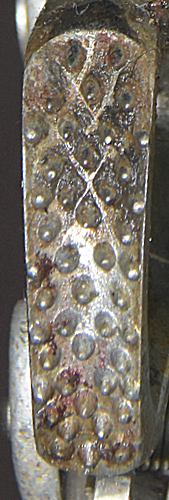Technical Details
Luc Bourguignon sent me this ascender in 2005, but it is much older, possibly from the 1970s.

The ascender is left-handed, as are virtually all chest ascenders
that I have seen. The ascender is 126 mm. high, 87 mm.
wide, 38 mm. thick, and weighs 174 grams. The ascender
shell is subtriangular shape bent from unfinished 4 mm. aluminum
sheet. The rope channel is formed by bending the right side of
the ascender into a U. The rope channel is 15.2 mm. wide. The main sling attachment point is located below the cam and behind
the rope channel. A second attachment point lies above the cam,
also behind the rope channel. The shell is bent backwards at both
points to provide clearance between the attachment slings and
the main rope. This accounts for the rather large thickness of
this ascender. The attachment points appear to be circles distorts
by the stamping operation. The lower attachment point measures
16 by 14.9 mm. and the upper 17 by 13 mm. A steel insert
protects the lower hole from wear. The left end of the shell is
bent on an inclined axis to form another U. A hole drilled through
both sides of the U accepts a steel rivet. The cam and cam spring
are mounted on this rivet, and a steel bushing protects the rear
of the aluminum shell from having the rivet pull through. The
pivot is centered 55 mm. from the inside of the rope channel.
The cam is a plated skeletonized steel casting. The cam radius,
measured from the pivot, increases from 38 to 52 mm. over
an angle of 44 degrees. The cam has number of small conical teeth,
all of which have their axes approximately parallel to the lower
surface of the cam. The tooth pattern is (2.3)(4.3)^5(2.3). A
spring-loaded manual safety bar is mounted in the cam channel
below the cam pivot. A cutout in the channel and a button on the
safety allow one to reach it with thumb or finger. The normal
action of the spring holds the safety against the cam channel.
Swinging it in and down allows the cam to open fully. A hook on
the cam safety can engage either of the two bottom tooth rows
to hold the cam open.
The back of the shell is stamped "EMILSA."
The cam safety is both awkward and unique. Opening the ascender
one-handed is quite difficult. When the cam hold-open is active,
the aggressive hook makes releasing the cam more difficult than
on most other designs.
The steel liner on the bottom attachment hole is not necessary,
and it does present a sharp edge at one place on the back of the
ascender. A tap with a hammer and a touch with a file should fix
this.
History
Emili Sabaté [1936-2006] was a prominent caver from Barcelona. He started making caving equipment in 1952, and initially sold his products directly to caving clubs. His products included helmets, carbide lamps, cable ladders, descenders, and ascenders. In 1961 he started selling some of his products in the Saber mountaineering equipment store in Barcelona.
Sabaté eventually formed EMILSA (derived from his name) to take control of his own sales and distribution. We do not know the exact date that he founded the company, but his trademark registration application was dated May 12, 1972. The application required some minor corrections, and it wasn't approved until March 17, 1977.
Ref.: José Manuel Sanchis. “Lámparas de Mina Españolas: Carbureros de Emili Sabaté, (EMILSA).” Uploaded to https://issuu.com/malacate/docs/emilsa by Jesus Alonzo, August 5, 2021.

For far more content, use a larger monitor and a full-width window.
Hundreds of cell phone users complained and asked me to for a simpler, mobile friendly site. In particular, they wanted me to limit each page to a small number of pictures and minimize my use of text. This new site provides what they asked for.

